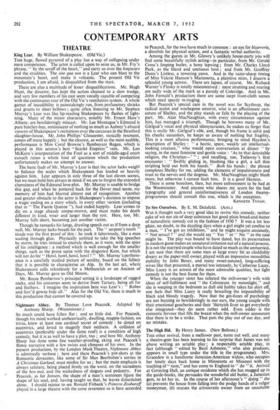CONTEMPORARY ARTS
THEATRE
King Lear. By William Shakespeare. (Old Vic.) Tins huge, flawed pyramid of a play has a way of collapsing under mere competence. The actor is called upon to seize us, in Mr. Fry's phrase, " by the scruff of the heart," and carry us over the longueurs and the crudities. The sine qua non is a Lear who can blast to the mountain's heart, and make it volcanic. The present Old Vic production, I am afraid, is disqualified from the start.
There are also a multitude of lesser disqualifications. Mr. Hugh Hunt, the director, has kept the action chained to a slow trudge, and very few members of his cast seem vocally capable of competing with the continuous roar of the Old Vic's ventilation system. A whole gamut of inaudibility is painstakingly run, from perfunctory shrieks and grunts to sheer bellows ; quite often listening to Mr. Stephen Murray's Lear was like lip-reading Shakespeare by flashes of light- ning. Many of the minor characters, notably Mr. Ernest Hare's Albany, are bewilderingly miscast. Mr. Lee Montague's Edmund is pure butcher-boy, reminiscent of nothing so much as Aubrey's absurd vignette of Shakespeare's recitations over the carcasses in the Stratford slaughter-house. Mr. John Phillips' Gloucester, stoically resonant, comes off more happily ; but the clearest, as well as the most audible, performance is Miss Coral Browne's flamboyant Regan, which is played in this actress's best " Scarlet Empress " vein. Mr. Leo McKem's interpretation, of the Fool as a sort of 'middle-aged court eunuch raises a whole host of questions which the production unfortunately makes no attempt to answer.
The basic fault of Mr. Murray's Lear is that the actor lacks weight to balance the scales which Shakespeare has loaded so heavily against him. Lear appears in only three of the last eleven scenes, but we must hold him always in mind if we are to forgive the extended clumsiness of the Edmund love-plot. Mr. Murray is unable to bridge this gap, and when he pottered back for the Dover mad scene, my memory of him had blurred almost out of recognition. Another and greater obstacle to the actor is Shakespeare's decision to impose a tragic ending on a story which, in every other version (including that in " The Faerie Queene "), had ended happily. Lear comes to die on a stage already corpse-strewn, and must make his death different in kind, wiser and larger than the rest. Here, too, Mr. Murray falls short, becoming just another victim.
Though he ransacks his lungs, dravfing speech out as if from a deep well, Mr. Murray lacks breath for the part. The " serpent's tooth " tirade was the first proof of this : he took it laboriously, like a man wading through glue. Physically unfitted to take the big speeches by storm, he tries instead to encircle them, as it were, with the spies of his intelligence : a method which is well enough for the smaller things, such as the prose scene with the disgusted Kent, but which will not do for " Howl, howl, howl, howl ! " Mr. Murray's perform- ance is a carefully studied picture of senility, based on the fallacy that it is possible to characterise an Alp. In the last act, where Shakespeare calls relentlessly for a Methuselah or an Ancient of Days, Mr. Murray gave us Old Moore.
Mr. Reece Pemberton's principal setting is a landscape of ragged rocks, and his costumes seem to derive from Tartary, being all fur and feathers. I imagine the inspiration here was Lear's : " Robes and furr'd gowns hide all." Alas for the Old Vic, there is much in this production that cannot be covered up.


































 Previous page
Previous page